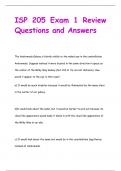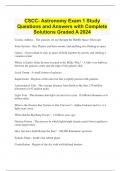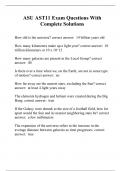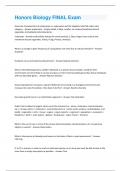How big is the universe - Study guides, Class notes & Summaries
Looking for the best study guides, study notes and summaries about How big is the universe? On this page you'll find 490 study documents about How big is the universe.
Page 2 out of 490 results
Sort by

-
ISP 205 Exam 1 Review Questions and Answers
- Exam (elaborations) • 39 pages • 2024
- Available in package deal
-
- $13.49
- + learn more
The Andromeda Galaxy is faintly visible to the naked eye in the constellation Andromeda. Suppose instead it were located in the same direction in space as the center of the Milky Way Galaxy (but still at its current distance). How would it appear to the eye in that case? a) It would be much brighter because it would be illuminated by the many stars in the center of our galaxy. b)It would look about the same, but it would be harder to pick out because its cloud-like appearance would m...

-
AST 111 final exam || with 100% Error-free Solutions.
- Exam (elaborations) • 6 pages • 2024
-
Available in package deal
-
- $10.79
- + learn more
big bang theory correct answers the universe was hot and dense at beginning, energy could be transformed into matter in these conditions, if everything is moving away it must have been close at one time, same place same time, explosion of space what are the fundamental forces of nature correct answers weak force, strong force, electromagnetism, and gravity inflation correct answers energy released near the end of the GUT era may have caused a dramatic expansion of the universe first evi...

-
CSCC- Astronomy Exam 1 Study Questions and Answers with Complete Solutions Graded A 2024
- Exam (elaborations) • 15 pages • 2024
-
- $14.99
- + learn more
Cosmic Address - The galaxies we see through the Hubble Space Telescope Solar System - Sun, Planets and their moons, and anything else floating in space Galaxy - Great island of stars in space all held together by gravity and orbiting a common center Where is Earth's Solar System Located in the Milky Way? - A little over halfway between the galactic center and the edge of the galactic disk Local Group - A small cluster of galaxies Supercluster - Regions of the universe that is ti...

-
Brooks Biodiversity Unit 1 Exam with Complete Solutions
- Exam (elaborations) • 22 pages • 2024
-
- $10.49
- + learn more
evolution the concept that all given organisms are related to each other though common ancestry Have scientists proven that life exists? No Big Bang Theory of how the universe formed 16-18 billion years ago Symbiosis the interaction between two different organisms living in close association "life coming together" Spontaneous Generation Theory that life arose spontaneously from inanimate matter. Not a widely held belief among scientists Biogenesis Hypothesis Theory that living matter c...

-
ASU AST11 Exam Questions With Complete Solutions
- Exam (elaborations) • 21 pages • 2023
-
- $12.99
- + learn more
How old is the universe? correct answer: 14 billion years old How many kilometers make up a light year? correct answer: 10 trillion kilometers or 10 x 10^12 How many galaxies are present in the Local Group? correct answer: 40 Is there ever a time when we, on the Earth, are not in some type of motion? correct answer: no How far away are the nearest stars, excluding the Sun? correct answer: at least 4 light years away The elements hydrogen and helium were created during the Big...

-
Brooks Biodiversity Unit 1 Exam with Complete Solutions
- Exam (elaborations) • 22 pages • 2024
- Available in package deal
-
- $9.99
- + learn more
Brooks Biodiversity Unit 1 Exam with Complete Solutions evolution the concept that all given organisms are related to each other though common ancestry Have scientists proven that life exists? No Big Bang Theory of how the universe formed 16-18 billion years ago Symbiosis the interaction between two different organisms living in close association "life coming together" Spontaneous Generation Theory that life arose spontaneously from inanimate matter. Not a widely held beli...

-
Science Olympiad quiz bowl latest version already passed
- Exam (elaborations) • 14 pages • 2024
- Available in package deal
-
- $9.99
- + learn more
Science Olympiad quiz bowl latest version already passed thermometer device that measures temperature clouds stratus, cirrus, and nimbus are types of these What country experiences the most tornadoes? United States of America rainbow spectrum of light that appears when the sun shines into water droplets in the air Blizzard created by low temperatures, heavy snow, strong winds wind described by the terms "breeze" and "gale" global warming human activity linked to the w...

-
Honors Biology FINAL Exam Questions With 100% Correct Answers!!
- Exam (elaborations) • 15 pages • 2024
- Available in package deal
-
- $8.39
- + learn more
Know the characteristics of prokaryotes vs. eukaryotes and the kingdoms that fall under each category. - Answer-prokaryotic - (single-celled, 3.5byo, smaller, no nucleus/membrane-bound organelles, Archaebacteria & Eubacteria) eukaryotic - (mostly multicellular (except for some protists), 1.5byo, larger, have nucleus and membrane-bound organelles, Plants, Fungi, Protists, Animals) What is a change in gene frequency of a population over time due to natural selection? - AnswerEvolution Evolut...

-
ASTRO 207 Midterm 1 Exam - Questions with Verified Answers
- Exam (elaborations) • 11 pages • 2024
-
- $16.99
- + learn more
ASTRO 207 Midterm 1 Exam - Questions with Verified Answers The amount of time between successive passes of any given star across the meridian is: A) 365.25 days B) 12 years C) 23 hours, 56 minutes D) 26,000 years E) 24 hours When someone on Earth observes the Moon in the first-quarter phase, someone on the Moon facing Earth observes Earth in the: A) new Earth phase B) crescent Earth phase C) third-quarter Earth phase D) full Earth phase E) first-quarter Earth phase What is a circumpolar star? ...

-
EESC 101 Exam 1 || with 100% Error-free Solutions.
- Exam (elaborations) • 9 pages • 2024
-
Available in package deal
-
- $11.29
- + learn more
How do we know about the formation of the solar system? correct answers Telescopes, rovers, probes, samples Who published work about heliocentrism? correct answers Copernicus What makes a planet a planet? correct answers 1. large body orbiting a star (in a regular pattern) 2. Nearly spherical 3. Cleared it's orbit of debris Zone 1 of the Solar System correct answers First four planets, terrestrial (rocky), small Zone 1.5 of the Solar System correct answers Asteroid belt lies betwe...

How did he do that? By selling his study resources on Stuvia. Try it yourself! Discover all about earning on Stuvia


